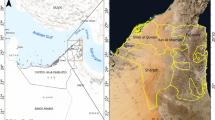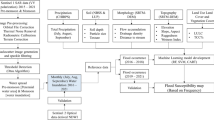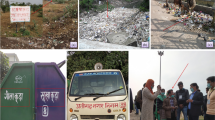Abstract
The Ant Miner algorithm was compared with the bivariate frequency ratio (FR) and boosted regression trees (BRT) algorithms in terms of its capacity to assess groundwater potential. A geospatial dataset was prepared that contains two components: a flowing well inventory map and eleven factors relevant to groundwater conditions. Average nearest neighbor technique was used to investigate the spatial pattern of flowing wells and to find the appropriate distance between flowing and nonflowing points in the study area. A wrapper approach known as random forest classifier and a filtering approach known as information gain ratio were used to identify the most relevant groundwater factors. The developed models were validated via the area under the operating characteristic curve. Results revealed that the Ant Miner model performed better in terms of both success (0.944) and prediction (0.92) rates compared to FR and BRT. Furthermore, the Ant Miner algorithm derived five simple, easily interpreted rules for predicting groundwater potential that can be used by hydrogeologists for identifying potential groundwater well locations with minimal effort and cost.











Similar content being viewed by others
References
Abeare SM (2009) Comparisons of boosted regression tree, GLM and GAM performance in the standardization of yellowfin tuna catch-rate data from the Gulf of Mexico Lonline Fishery. Master’s Thesis, Louisiana State University
Abraham A, Ramos V (2003) Web usage mining using artificial ant colony clustering and linear genetic programming. Evolutionary computation conference, vol. 2. IEEE pp 1284–1391
Ahmed Z, Glasgow J (2012) Swarm Intelligence: concepts, models and applications. Technical report 2012-585. School of Computing, Queen’s University. Canada, p 51
Al-Abadi AM (2015) Modeling of groundwater productivity in northeastern Wasit Governorate. Iraq by using frequency ratio and Shannon’s entropy models. Appl Water Sci. doi:10.1007/s13201-015-0283-1
Al-Abadi AM, Shahid S (2016) Spatial mapping of artesian zone at Iraqi southern desert using a GIS-based random forest machine learning model. Model Earth Syst Environ. doi:10.1007/s40808-016-0150-6
Al-Abadi AM, Al-Temmeme AA, Al-Ghanimy MA (2016) A GIS-based combining of frequency ratio and index of entropy approaches for mapping groundwater availability zones at Badra-Al Al-Gharbi-Teeb areas, Iraq. Sustain Water Resour Manag. doi:10.1007/s40899-016-0056-5
Aouragh MH, Essahlaoui A, El Ouali A, El Hmaidi A, Kamel S (2016) Groundwater potential of Middle Atlas plateaus, Morocco, using fuzzy logic approach, GIS and remote sensing. Geomat Nat Hazards Rick. doi:10.1080/19475705.2016.1181676
Bellen RC Van, Dunnington HV, Wetzel R, Morton D (1959) LexiqueStratigraphique Internal Asie. Iraq Intern Geol Conger Comm Stratig 3, Fasc 10a, p 333
Bonham-Carter GF (1994) Geographic information systems for geoscientists, modeling with GIS. Pergamon Press, Oxford
Breiman L (2001) Random forests. Mach Learn 45(1):5–32. doi:10.1023/A:1010933404324
Bullnheimer B, Hartl RF, Strauß C (1997) A New Rank Based Version of the Ant System: A Computational Study. Working Paper No. 1. Vienna University of Economics, Austria. p 17
Carranza EJM, Laborte AG (2014) Random forest predictive modeling of mineral prospectivity with small number of prospects and data with missing values in Abra (Philippines). Comput Geosci 74:60–70. doi:10.1016/j.cageo.2014.10.004
Clark PJ, Evans FC (1954) Distance to nearest neighbor as a measure of spatial relationships in populations. Ecology 35(4):445–453
Colorni A, Dorigo M, Maniezzoetal V (1991) Distributed optimization by ant colonies. In: Proceedings of European Conference on Artificial Life, Paris, France, pp. 134–142
Corsini A, Cervi F, Ronchetti F (2009) Weight of evidence and artificial neural networks for potential groundwater mapping: an application to the Mt. Modino area (Northern Apennines, Italy). Geomorphology 111:79–87. doi:10.1016/j.geomorph.2008.03.015
Costa E, Lorena A, Carvalho A, Freitas A, Holden N (2007) Comparing several approaches for hierarchical classification of proteins with decision trees. In: 2nd Brazilian symposium on bioinformatics, Angra. Dos Reis, Brazil, pp. 126–137. doi: 10.1007/978-3-540-73731-5_12
de Winner G, Jewitt GPW, Horan M (2007) A GIS-based approach for identifying potential runoff harvesting sites in the Thukela River basin, South Africa. Phys Chem Earth 32:1058–1067. doi:10.1016/j.pce.2007.07.009
Dorigo M, Gambardella LM (1997) Ant colony system: a cooperative learning approach to the traveling salesman problem. IEEE Trans Evol Comput 1(1):53–66. doi:10.1109/4235.585892
Dorigo M, Stützle T (2004) Ant colony optimization. The MIT press, London, p 320
Dorigo M, Maniezzo V, Colorni A (1991) Positive feed-back as a search strategy. Tech. Rept. 91–016. Dipartimento di Elettronica, Politecnico di Milano, Italy
Dorigo M, Maniezzo V, Colorni A (1996) The Ant System: optimization by a colony of cooperating agents. IEEE Trans Syst Man Cybern Part B 26(1):29–41. doi:10.1109/3477.484436
Elith J, Leathwick JR, Hastie T (2008) A working guide to boosted regression tress. J Animal Ecology 77(4):802–813. doi:10.1111/j.1365-2656.2008.01390.x
Handl J, Knowles J, Dorigo M (2006) Ant-Based clustering and topographic mapping. Artif Life 12(1):35–61. doi:10.1162/106454606775186400
Israil M, Al-hadithi M, Singhal DC, Kumar B, Rao MS, Verma K (2006) Groundwater resources evaluation in the Piedmont zone of Himalaya, India, using isotope and GIS technique. J Spat Hydrol 6:34–38
Jassim SZ, Goff JC (2006) Geology of Iraq. Brno, Dolin, p 431
Kohavi R, John GH (1997) Wrappers for feature subset selection. Artif Intell 97(1–2):273–324. doi:10.1016/S0004-3702(97)00043-X
Kuhn M, Johnson K (2013) Applied predictive modeling. Springer, New York, p 615p
Kursa MB, Rudnicki WR (2010) Feature selection with the Boruta Package. J Stat Softw 36(11):1–13
Lai C, Shaoc Q, Chenb X, Wang Z, Zhoua X, Yangb B, Zhangb L (2016) Flood risk zoning using a rule mining based on ant colony algorithm. Hydrol J 542:268–280. doi:10.1016/j.jhydrol.2016.09.003
Lee S, Lee C-W (2015) Application of decision -tree model to groundwater productivity-potential mapping. Sustainability 7:13416–13432. doi:10.3390/su71013416
Lee S, Song K, Kim Y, Park I (2012) Regional groundwater productivity potential mapping using a geographic information system (GIS) based artificial neural network model. Hydrogeol J 20(8):1511–1527. doi:10.1007/s10040-012-0894-7
Liu B, Abbas HA, McKay RI (2003) Classification Rule Discovery with ant Colony Optimization. IEEE/WIC international conference on intelligent agent technology, 2003. IAT 2003. doi: 10.1109/IAT.2003.1241052
Liu XP, Li X, Liu L, He J, Ai B (2008) An innovative method to classify remote sensing images using ant colony optimization. IEEE Trans Geosci Remote Sens 46(22):4198–4208. doi:10.1109/TGRS.2008.2001754
McDonald RC, Isbell RF, Speight JG, Walker J, Hopkins MS (1990) Australian soil and land survey: field handbook, 2nd edn. Inkata Press, Melbourne
Naghibi SA, Pourghasemi HR, Pourtaghi ZS, Rezaei A (2014) Groundwater qanat potential mapping using frequency ratio and Shannon’s entropy models in the Moghan watershed, Iraq. Earth Sci Inform (2014). doi: 10.1007/s12145-014-0145-7
Naghibi SA, Pourghasemi HR, Dixon B (2016) Groundwater spring potential using boosted regression tree, classification and regression tree, and random forest machine learning models in Iran. Environ Monit Assess 188 (2016). doi.10.1007/s10661-015-5049-6
Nampak H, Pradhan B, Manap MA (2014) Application of GIS based data driven evidential belief function model to predict groundwater potential zonation. J Hydrol 513:283–300. doi:10.1016/j.jhydrol.2014.02.053
Nilsson R, Peña JM, BjÖrkegren J, Tegnér J (2007) Consistent feature selection for pattern recognition in polynomial time. J Mach Learn Res 8:589–612
Oh HJ, Kim YS, Choi JK, Park E, Lee S (2011) GIS mapping of regional probabilistic groundwater potential in the area of Pohang City, Korea. J Hydrol 399:158–172
Omkar SN, Raghavendra KU (2008) Rule extraction for classification of acoustic emission signals using Ant Colony optimization. Eng Appl Artif Intell 21(8):1381–1388. doi:10.1016/j.engappai.2008.02.004
Ozdemir A (2011) GIS-based groundwater spring potential mapping in the Sultan Mountains (Konya, Turkey) using frequency ratio, weights of evidence and logistic regression methods and their comparison. J Hydrol 411:290–308. doi:10.1016/j.jhydrol.2011.10.010
Pacheco FAL, Alencoão AMP (2002) Occurrence of springs in massifs of crystalline rocks, northern Portugal. Hydrogeol J 10(2):239–253. doi:10.1007/s10040-001-0186-0
Pacheco FAL, Van der Weijden CH (2014) Modeling rock weathering in small watersheds. J Hydrol 513C:13–27. doi:10.1016/j.jhydrol.2014.03.036
Parpinelli RS, Lopes HS, Freitas AA (2002) Data mining with an ant colony optimization algorithm. IEEE Trans Evolution Comput 6(4):321–332. doi:10.1109/TEVC.2002.802452
Parsons RM (1955) Groundwater resource of Iraq, vol 4. Development Board, Ministry of Development, Government of Iraq, Kirkuk liwa, p 142
Peterson WW, Birdsall TG, Fox WC (1954) The theory of signal detectability. Trans IRE Prof Group Inf Theroy PGIT 2–4:171–212. doi:10.1109/TIT.1954.1057460
Pourtaghi ZS, Pourghasemi HR (2014) GIS-based groundwater spring potential assessment and mapping in the Birjand Township, southern Khorasan Province, Iran. Hydrogeol J 22:643–662. doi:10.1007/s10040-013-1089-6
Pradhan B (2013) A comparative study on the predictive ability of the decision tree, support vector machine and neuro-fuzzy models in landslide susceptibility mapping using GIS. Comput Geosci 51:350–365. doi:10.1016/j.cageo.2012.08.023
Wang ZL, Lai CG, Chen XH, Yang B, Zhao SW, Bai XY (2015) Flood hazard risk assessment model based on random forest. J Hydrol 527:1130–1141
Witten IH, Frank E, Hall MA (2011) Data Mining: Practical Machine Learning Tools and Techniques. Morgan Kaufmann, San Francisco
Yesilnacar E, Topal T (2005) Landslide susceptibility mapping: a comparison of logistic regression and neural networks methods in a medium scale study, Hendek region (Turkey). Eng Geol 79(3–4):251–266. doi:10.1016/j.enggeo.2005.02.002
Zare M, Pourghasemi HR, Vafakhah M, Pradhan B (2013) Landslide susceptibility mapping at Vaz watershed (Iran) using an artificial neural network model: a comparison between multi-layer perceptron (MLP) and radial basic function (RBF) algorithms. Arab J Geosci 6(8):2873–2888. doi:10.1007/s12517-012-0610-x
Zou KH, O’Malley J, Mauri L (2007) Receiver-operating characteristic analysis for evaluating diagnostic tests and predictive models. Circulation 115:654–657. doi:10.1161/CIRCULATIONAHA.105.594929
Author information
Authors and Affiliations
Corresponding author
Rights and permissions
About this article
Cite this article
Al-Abadi, A.M. A novel geographical information system-based Ant Miner algorithm model for delineating groundwater flowing artesian well boundary: a case study from Iraqi southern and western deserts. Environ Earth Sci 76, 534 (2017). https://doi.org/10.1007/s12665-017-6876-2
Received:
Accepted:
Published:
DOI: https://doi.org/10.1007/s12665-017-6876-2




